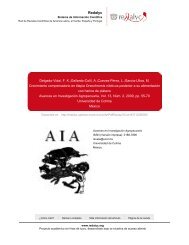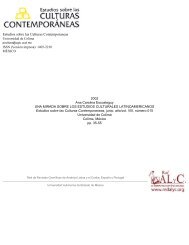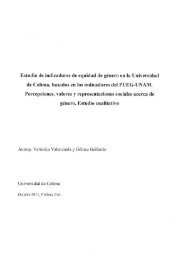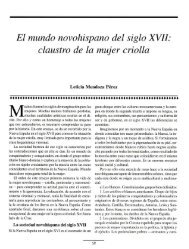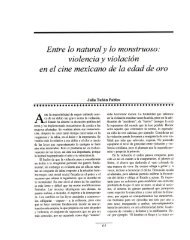Redalyc.AnomalÃas del desarrollo testicular y escrotal en toros de ...
Redalyc.AnomalÃas del desarrollo testicular y escrotal en toros de ...
Redalyc.AnomalÃas del desarrollo testicular y escrotal en toros de ...
You also want an ePaper? Increase the reach of your titles
YUMPU automatically turns print PDFs into web optimized ePapers that Google loves.
<strong><strong>de</strong>l</strong> <strong><strong>de</strong>sarrollo</strong> <strong>testicular</strong> y <strong>escrotal</strong> <strong>en</strong> <strong>toros</strong> <strong>de</strong>Anomalíasrazas <strong>en</strong> el sureste <strong>de</strong> MéxicotresRevista <strong>de</strong> investigación y difusión ci<strong>en</strong>tífica agropecuariaAbnormalities of <strong>testicular</strong> and scrotal <strong>de</strong>velopm<strong>en</strong>t in bulls of threebreeds in southeast MéxicoSilva, C.; Delgado, R.; Magaña, J. y Reyes, A.Resum<strong>en</strong>Con el fin <strong>de</strong> estudiar la frecu<strong>en</strong>cia <strong>de</strong> anomalías<strong><strong>de</strong>l</strong> <strong><strong>de</strong>sarrollo</strong> <strong>testicular</strong> y <strong>escrotal</strong>, se examinaron203 <strong>toros</strong> Brahman (B), 160 Nelore(N) y 218 Pardo Suizo (PS), <strong>de</strong> 6 a 24 meses<strong>de</strong> edad. El exam<strong>en</strong> se hizo por inspección y palpación<strong>de</strong> los testículos y el escroto. Se incluyeronhipoplasia, criptorquidia, <strong>de</strong>sc<strong>en</strong>so <strong>testicular</strong> incompletoy <strong><strong>de</strong>sarrollo</strong> <strong>de</strong>fectuoso <strong><strong>de</strong>l</strong> escroto (escrotocuneiforme). Se hizo la comparación <strong>en</strong>trerazas con la prueba <strong>de</strong> Chi cuadrada. Las frecu<strong>en</strong>cias<strong>de</strong> anomalías fueron <strong>de</strong> 8.37, 6.87 y6.88% <strong>en</strong> los <strong>toros</strong> B, N y PS, respectivam<strong>en</strong>te(P> 0.05). Las anomalías más comunes fueron:la hipoplasia (2 a 3.5% <strong>de</strong> casos <strong>en</strong> las tresrazas) y el <strong>de</strong>sc<strong>en</strong>so <strong>testicular</strong> incompleto (1 a3% <strong>en</strong> las tres razas), seguidas por el escroto cuneiforme(1.5 a 4% <strong>en</strong> las razas B y N) y lacriptorquidia (0.5 a 1% <strong>en</strong> las razas B y PS). Laanomalía más frecu<strong>en</strong>te <strong>en</strong> B fue la hipoplasia(3.45%). En la raza N fue más frecu<strong>en</strong>te el escrotocuneiforme (3.75%) y no se observó criptorquidia.En la PS, la anomalía más frecu<strong>en</strong>tefue también la hipoplasia (3.21%) y no se observóescroto cuneiforme. La única difer<strong>en</strong>cia signi-Facultad <strong>de</strong> Medicina Veterinaria y ZootecniaUniversidad Autónoma <strong>de</strong> YucatánKm. 15.5 Carretera Mérida-XmatkuilMérida, YucatánCorrespond<strong>en</strong>cia: csilva@tunku.uady.mxAbstractIn or<strong>de</strong>r to study the frequ<strong>en</strong>cy of <strong>testicular</strong>and scrotal <strong>de</strong>velopm<strong>en</strong>tal abnormalities, 203Brahman (B), 160 Nelore (N), and 218 BrownSwiss (BS) bulls from 6 to 24 months old wereexamined. The examination was done by inspectionand palpation of the testes and scrotum. Hypoplasia,cryptorchidism, incomplete <strong>testicular</strong> <strong>de</strong>sc<strong>en</strong>t,and abnormal <strong>de</strong>velopm<strong>en</strong>t of the scrotum(wedge-shaped scrotum) were inclu<strong>de</strong>d in the study.Comparison among breeds was done with Chisquare test. The observed frequ<strong>en</strong>cies of abnormalitieswere: 8.37, 6.87 and 6.88 % in the B,N and BS bulls, respectively (P> 0.05). Themost common abnormalities were hypoplasia (2to 3.5 % in the three breeds) and incomplete <strong>testicular</strong><strong>de</strong>sc<strong>en</strong>t (1 to 3 % in the three breeds), followedby the wedge-shaped scrotum (1.5 to 4 % inB and N) and cryptorchidism (0.5 to 1 % in Band BS). The most common abnormality in Bwas hypoplasia (3.45%); in N it was the wedgeshapedscrotum (3.75%), and cryptorchidism wasnot observed. In BS, hypoplasia was also the mostfrequ<strong>en</strong>t anomaly (3.21%), and wedge-shapedscrotum was abs<strong>en</strong>t. The only significant differ<strong>en</strong>-AVANCES EN INVESTIGACIÓN AGROPECUARIASilva et al. AIA. 12(3): 21-31ISSN 0188789-0• 21



